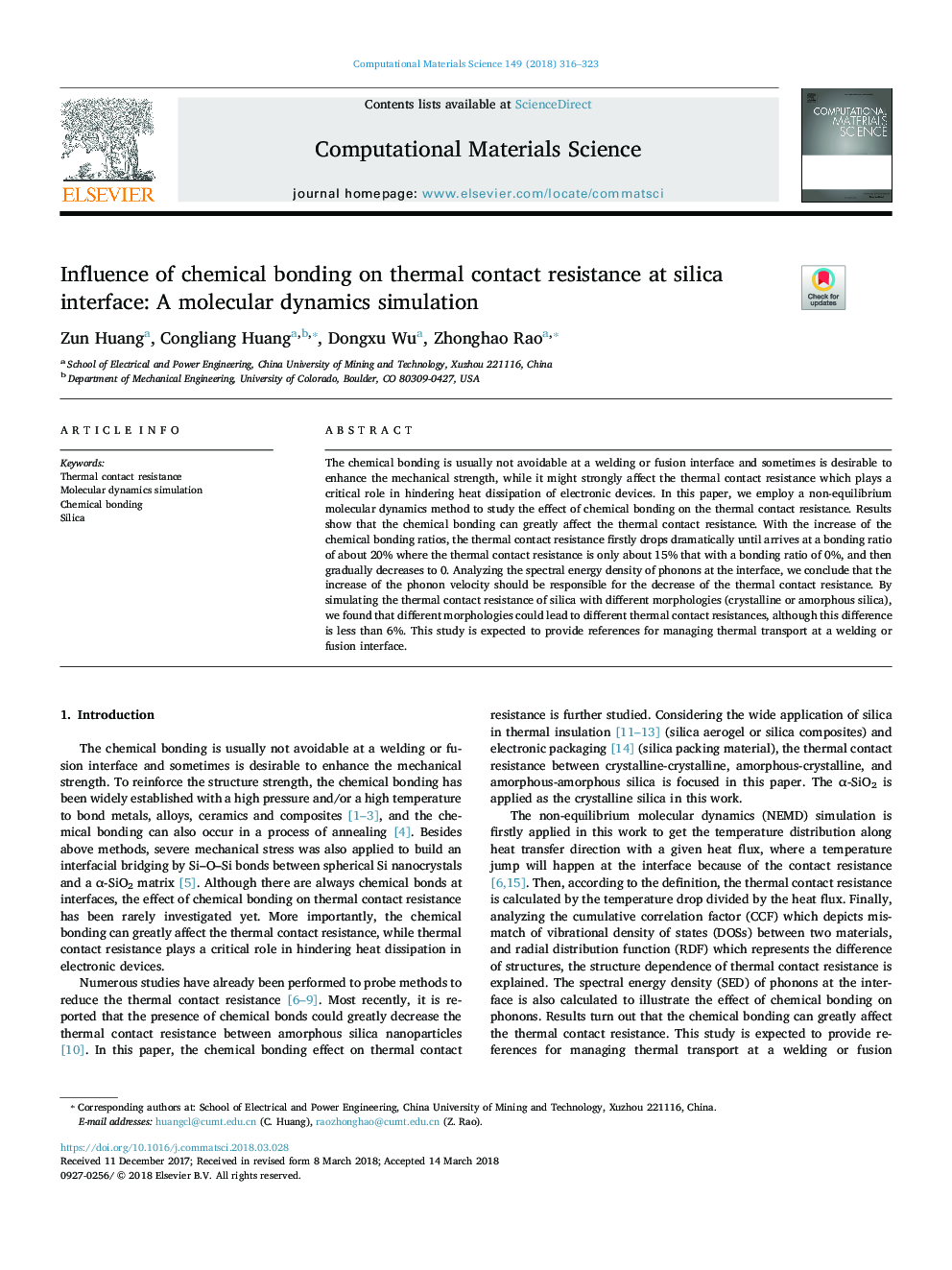| کد مقاله | کد نشریه | سال انتشار | مقاله انگلیسی | نسخه تمام متن |
|---|---|---|---|---|
| 7957603 | 1513863 | 2018 | 8 صفحه PDF | دانلود رایگان |
عنوان انگلیسی مقاله ISI
Influence of chemical bonding on thermal contact resistance at silica interface: A molecular dynamics simulation
ترجمه فارسی عنوان
تأثیر پیوند شیمیایی در مقاومت به تماس حرارتی در سیلیس رابط: یک شبیه سازی دینامیک مولکولی
دانلود مقاله + سفارش ترجمه
دانلود مقاله ISI انگلیسی
رایگان برای ایرانیان
کلمات کلیدی
مقاومت در برابر حرارت، شبیه سازی دینامیک مولکولی، پیوند شیمیایی، سیلیکا،
ترجمه چکیده
پیوند شیمیایی معمولا در یک اتصال جوشکاری یا همجوشی اجتناب ناپذیر است و گاهی اوقات برای تقویت مقاومت مکانیکی مطلوب است، در حالی که ممکن است به شدت بر مقاومت مقاومت حرارتی تاثیر بگذارد که نقش مهمی در جلوگیری از انهدام گرما در دستگاه های الکترونیکی ایفا می کند. در این مقاله، روش پویایی مولکولی غیر تعادل را برای بررسی اثر اتصال شیمیایی بر مقاومت تماس حرارتی استفاده می کنیم. نتایج نشان می دهد که پیوند شیمیایی می تواند تا حد زیادی بر مقاومت تماس حرارتی تاثیر بگذارد. با افزایش نسبت پیوندی شیمیایی، مقاومت حرارت حرارتی در ابتدا به طور چشمگیری کاهش می یابد تا نسبت به اتصال حدود 20 درصد جابجا شود، در حالیکه مقاومت تماس حرارتی تنها حدود 15 درصد است که با نسبت پیوند 0 درصد است و سپس به تدریج کاهش می یابد 0. با تجزیه و تحلیل چگالی انرژی طیفی فونون ها در رابط، ما نتیجه می گیریم که افزایش سرعت فونون باید باعث کاهش مقاومت تماس حرارتی شود. با شبیه سازی مقاومت حرارت حرارتی سیلیس با مورفولوژی های مختلف (سیلیس بلورین یا آمورف)، ما دریافتیم که مورفولوژی های مختلف می توانند به مقاومت در برابر تماس های مختلف منجر شوند، اگرچه این تفاوت کمتر از 6 درصد است. انتظار می رود این مطالعه برای ارایه منابع مدیریت حمل و نقل حرارتی در یک رابط جوش یا فیوژن ارائه کند.
موضوعات مرتبط
مهندسی و علوم پایه
سایر رشته های مهندسی
مکانیک محاسباتی
چکیده انگلیسی
The chemical bonding is usually not avoidable at a welding or fusion interface and sometimes is desirable to enhance the mechanical strength, while it might strongly affect the thermal contact resistance which plays a critical role in hindering heat dissipation of electronic devices. In this paper, we employ a non-equilibrium molecular dynamics method to study the effect of chemical bonding on the thermal contact resistance. Results show that the chemical bonding can greatly affect the thermal contact resistance. With the increase of the chemical bonding ratios, the thermal contact resistance firstly drops dramatically until arrives at a bonding ratio of about 20% where the thermal contact resistance is only about 15% that with a bonding ratio of 0%, and then gradually decreases to 0. Analyzing the spectral energy density of phonons at the interface, we conclude that the increase of the phonon velocity should be responsible for the decrease of the thermal contact resistance. By simulating the thermal contact resistance of silica with different morphologies (crystalline or amorphous silica), we found that different morphologies could lead to different thermal contact resistances, although this difference is less than 6%. This study is expected to provide references for managing thermal transport at a welding or fusion interface.
ناشر
Database: Elsevier - ScienceDirect (ساینس دایرکت)
Journal: Computational Materials Science - Volume 149, 15 June 2018, Pages 316-323
Journal: Computational Materials Science - Volume 149, 15 June 2018, Pages 316-323
نویسندگان
Zun Huang, Congliang Huang, Dongxu Wu, Zhonghao Rao,
